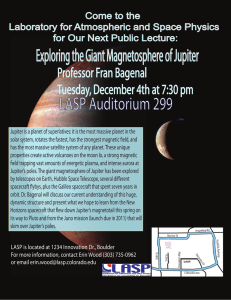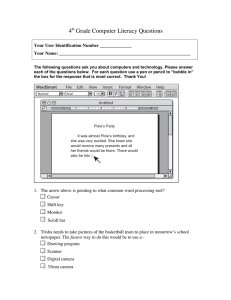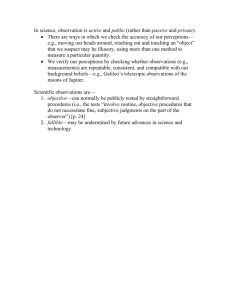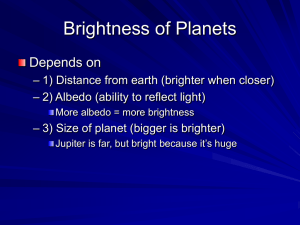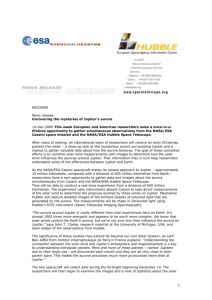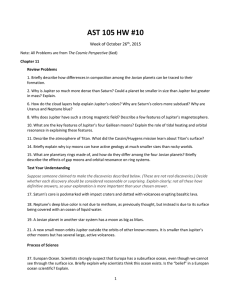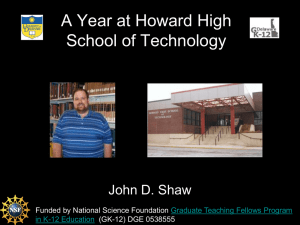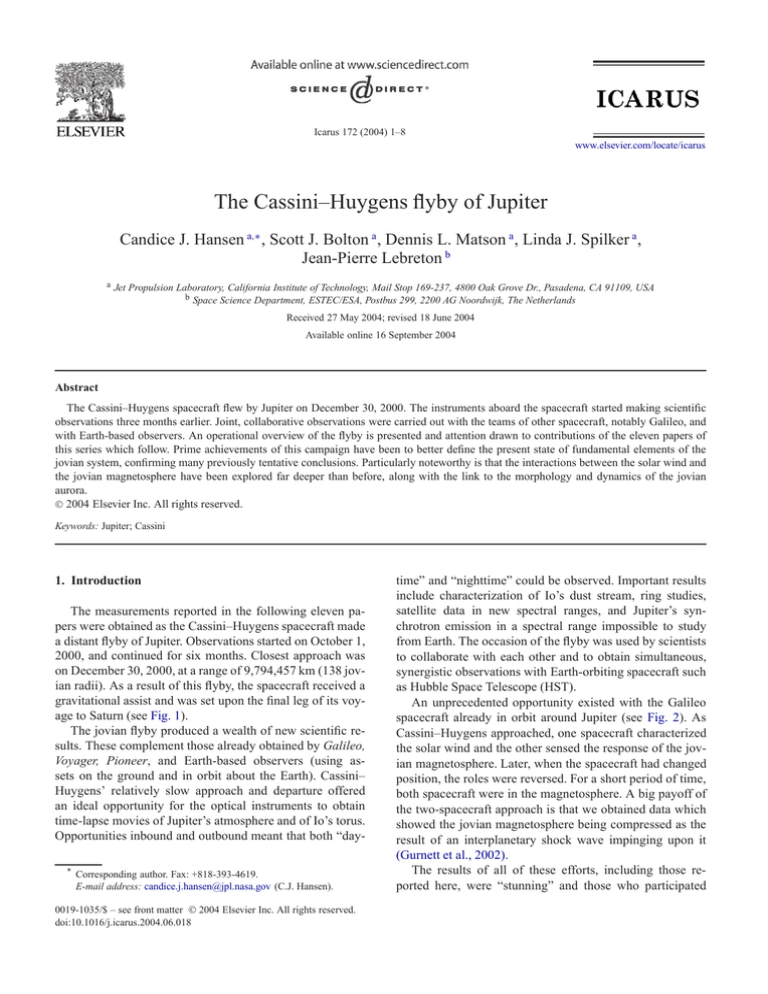
Icarus 172 (2004) 1–8
www.elsevier.com/locate/icarus
The Cassini–Huygens flyby of Jupiter
Candice J. Hansen a,∗ , Scott J. Bolton a , Dennis L. Matson a , Linda J. Spilker a ,
Jean-Pierre Lebreton b
a Jet Propulsion Laboratory, California Institute of Technology, Mail Stop 169-237, 4800 Oak Grove Dr., Pasadena, CA 91109, USA
b Space Science Department, ESTEC/ESA, Postbus 299, 2200 AG Noordwijk, The Netherlands
Received 27 May 2004; revised 18 June 2004
Available online 16 September 2004
Abstract
The Cassini–Huygens spacecraft flew by Jupiter on December 30, 2000. The instruments aboard the spacecraft started making scientific
observations three months earlier. Joint, collaborative observations were carried out with the teams of other spacecraft, notably Galileo, and
with Earth-based observers. An operational overview of the flyby is presented and attention drawn to contributions of the eleven papers of
this series which follow. Prime achievements of this campaign have been to better define the present state of fundamental elements of the
jovian system, confirming many previously tentative conclusions. Particularly noteworthy is that the interactions between the solar wind and
the jovian magnetosphere have been explored far deeper than before, along with the link to the morphology and dynamics of the jovian
aurora.
2004 Elsevier Inc. All rights reserved.
Keywords: Jupiter; Cassini
1. Introduction
The measurements reported in the following eleven papers were obtained as the Cassini–Huygens spacecraft made
a distant flyby of Jupiter. Observations started on October 1,
2000, and continued for six months. Closest approach was
on December 30, 2000, at a range of 9,794,457 km (138 jovian radii). As a result of this flyby, the spacecraft received a
gravitational assist and was set upon the final leg of its voyage to Saturn (see Fig. 1).
The jovian flyby produced a wealth of new scientific results. These complement those already obtained by Galileo,
Voyager, Pioneer, and Earth-based observers (using assets on the ground and in orbit about the Earth). Cassini–
Huygens’ relatively slow approach and departure offered
an ideal opportunity for the optical instruments to obtain
time-lapse movies of Jupiter’s atmosphere and of Io’s torus.
Opportunities inbound and outbound meant that both “day* Corresponding author. Fax: +818-393-4619.
E-mail address: candice.j.hansen@jpl.nasa.gov (C.J. Hansen).
0019-1035/$ – see front matter 2004 Elsevier Inc. All rights reserved.
doi:10.1016/j.icarus.2004.06.018
time” and “nighttime” could be observed. Important results
include characterization of Io’s dust stream, ring studies,
satellite data in new spectral ranges, and Jupiter’s synchrotron emission in a spectral range impossible to study
from Earth. The occasion of the flyby was used by scientists
to collaborate with each other and to obtain simultaneous,
synergistic observations with Earth-orbiting spacecraft such
as Hubble Space Telescope (HST).
An unprecedented opportunity existed with the Galileo
spacecraft already in orbit around Jupiter (see Fig. 2). As
Cassini–Huygens approached, one spacecraft characterized
the solar wind and the other sensed the response of the jovian magnetosphere. Later, when the spacecraft had changed
position, the roles were reversed. For a short period of time,
both spacecraft were in the magnetosphere. A big payoff of
the two-spacecraft approach is that we obtained data which
showed the jovian magnetosphere being compressed as the
result of an interplanetary shock wave impinging upon it
(Gurnett et al., 2002).
The results of all of these efforts, including those reported here, were “stunning” and those who participated
2
C.J. Hansen et al. / Icarus 172 (2004) 1–8
Fig. 1. Cassini was launched in October 1997 on a trajectory that would bring it to Saturn in 2004. This trajectory used gravity assists from Venus, Earth, and
Jupiter. The Jupiter flyby offered an opportunity to achieve new Jupiter science results in addition to exercising spacecraft instruments and teams in a manner
that emulated the Saturn tour operations.
were “. . . richly rewarded for their efforts.” (Hill, 2004). For
the Cassini–Huygens team, in addition to the scientific treasure trove, the flyby provided a dress rehearsal for the types
of operations that would be carried out later, in orbit about
Saturn. This experience has proved to be invaluable.
The literature on Cassini–Huygens is still relatively
small, compared to the size it will have at the end of the
Saturn science mission. A number of books and articles describe the mission and the hardware. Results from the Venus
and Earth flybys appeared in a series of eleven papers in
the Journal of Geophysical Research. Early results from
the flyby of Jupiter appeared as a series of eight papers in
Nature. Further results will appear in a series of seventeen
papers in the Journal of Geophysical Research, and eleven
papers in this issue of Icarus.
2. Observing with Cassini
The Cassini spacecraft has neither a scan platform nor
a rotating, fields-and-particles, turntable. As can be seen in
Fig. 3, the entire spacecraft must be turned to point the instruments. In this sense Cassini is similar to the great observatories such as Hubble. Cooperation is the order of the
day. Each instrument defines the observations that they desire to make. The process of combining all of the instrument timelines into a single, conflict-free, timeline is called
“integration.” The integration of Cassini’s diverse experiments was particularly challenging and led to development
of “templates.” A “template” is a fixed format for arranging a
collection of observations. It specifies the relations between
observations in the template and the protocols by which the
template interacts with other elements in the timeline.
When instruments are pointed at their targets the spacecraft high gain antenna is typically not pointed at Earth
Fig. 2. The Cassini Jupiter flyby trajectory is shown along with the orbit of
the Galileo spacecraft, projected on the ecliptic plane. The sun is in the +Y
direction, off the top of the figure. Cassini’s slow flyby enabled a 6 month
study of the dynamics of the atmosphere of Jupiter and Io’s torus. During
the approach the Cassini spacecraft was out in the solar wind in front of the
bowshock of Jupiter’s magnetosphere, while Galileo was in Jupiter’s magnetosphere. As the Cassini spacecraft flew on past Jupiter, the spacecraft
skirted along the edge of the magnetosheath. The boundary crossed over
the spacecraft a number of times as it left Jupiter’s environs.
so all data must be recorded on the Solid State Recorder
(SSR). The Cassini SSR holds 3.6 Gbits of data. To play
back the data, the High Gain Antenna (HGA), aligned along
the spacecraft −Z axis (see Fig. 3), is pointed to Earth. The
spacecraft is 3-axis stabilized and can use either reaction
wheels or thrusters. Most of the jovian flyby was carried
Cassini–Huygens Jupiter flyby
3
Fig. 3. The Cassini spacecraft carries three groups of instruments: Optical Remote Sensing (ORS), Magnetospheric and Plasma Science (MAPS), and Microwave Remote Sensing. The spacecraft has no scan platform to point the ORS instruments, no rotating fields and particles turntable, and the High Gain
Antenna (HGA) is fixed. As a result the entire spacecraft must be turned to point at a target or relay data to Earth.
out on reaction wheels. However, an anomaly fourteen days
before closest approach (December 16, 2000) caused a temporary switch to thrusters.
3. Inbound observations and science results
The templates developed for approach observations were
approximately 120 hr (5 days) in duration and were divided
into 12 ten-hour segments. Within a segment approximately
9 hr were used for observations and ∼ 1 hr was allocated
to turn the spacecraft 90◦ to the next orientation. The −Y
axis, along which the Optical Remote Sensing (ORS) instruments are boresighted, was pointed at Jupiter for 10 hr every
other segment. Every 4th segment had −Z, the High Gain
Antenna, pointed at Earth for data downlink. As illustrated
in Table 1 the intervening segments were −X to the Sun to
point the Magnetosphere and Plasma Science (MAPS) instruments to observe the solar wind, and −Z to the Sun to
point CDA to observe dust streams from Jupiter. Segments
5, 6, and 7 pointed the ORS instruments at Jupiter continuously to monitor atmospheric and torus variability on shorter
timescales. Radio and Plasma Wave Science (RPWS) antennas were calibrated with a special offset relative to Jupiter
during the second segment of the second template. When
the sun and Earth are close enough together in the sky the
spacecraft may roll around the Z axis for MAPS observations, because the Visible and Infrared Mapping Spectrometer (VIMS) and Composite InfraRed Spectrometer (CIRS)
radiators are shaded by the HGA. This was the case during
part of the approach phase. When the sun and Earth are separated by more than 4.5◦ the spacecraft is not allowed to
roll because that would rotate the radiators into the sun and
VIMS and CIRS would become too warm.
Wind velocities and life cycles of atmospheric features
were measured and interactions of storms and jets were
monitored during the inbound 3-month “zoom” movie, executed for all odd rotations of Jupiter from −90 to −25 days,
plus one even rotation per 120 hr template. Data was acquired continuously by CIRS and the UltraViolet Imaging Spectrograph (UVIS). The Imaging Science Subsystem
(ISS) and VIMS imaged every 60◦ of longitude. Cassini was
able to study jovian atmospheric dynamics and meteorology over time scales ranging from hours to months (Porco
et al., 2003). This key objective of the Galileo mission was
thwarted when the Galileo high gain antenna failed to deploy. High spatial resolution CIRS temperature maps led to
the discovery of an intense stratospheric jet (Flasar et al.,
2004). Properties and lifetimes of over 500 spots, and the
relationship between spots and the mean zonal wind profile
were investigated (Li et al., 2004).
Cassini monitored emissions from ions and neutrals in
Io’s torus to study sources and sinks of material, composition, dynamics, dependencies on local time, Io’s phase,
jovian longitude and Io’s volcanic activity. Beginning at
−90 days and ending at −25 days UVIS routinely collected
torus data during every zoom movie rotation. In a 5 day period, 70 hr were spent monitoring Io’s torus. A time-lapse
4
C.J. Hansen et al. / Icarus 172 (2004) 1–8
Table 1
The spacecraft carried out these 120 hr templates in order to share observing time with a simple to implement observation set
Segment
1
2
3
4
5
6
7
8
9
10
11
12
Spacecraft orientations
−90 to −45 days
−45 to −25 days
+22 to +82 days
−Y to Jupiter
−Z to Sun, rolling
−Y to Jupiter
−Z to Sun
−Y to Jupiter
−Y to Jupiter
−Y to Jupiter
−Z to Earth, playback
−Y to Jupiter
−X to Sun, rotating
−Y to Jupiter
−X to Sun, rotating,
−Z to Earth, playback
−Y to Jupiter
RPWS calibration attitude
−Y to Jupiter
−Z to Earth, rolling, playback
−Y to Jupiter
−Y to Jupiter
−Y to Jupiter
−Z to Earth, rolling, playback
−Y to Jupiter
−X to Sun, rotating
−Y to Jupiter
−X to Sun, rotating,
−Z to Earth, rolling, playback
−Y to Jupiter
−X to Sun
−Y to Jupiter
−Z to Earth, playback
−Y to Jupiter
−Y to Jupiter
−Y to Jupiter
−Z to Earth, playback
−Y to Jupiter
−X to Sun
−Y to Jupiter
−Z to Earth
The segments with −Y to Jupiter pointed the ORS instruments at Jupiter for time-lapse movies of the atmosphere and torus, −Z to Earth pointed the High
Gain Antenna to Earth for data downlink, and −X to Sun was the best attitude for solar wind and dust observations.
torus movie has been assembled and brightness fluctuations
of the torus compared to solar wind and auroral phenomena.
Results are reported in (Steffl et al., 2004).
Coordinated observations by both Cassini and Galileo
offered the unique opportunity to simultaneously observe
the solar wind and Jupiter’s magnetosphere. Cassini in situ
measurements of the upstream solar wind conditions while
Galileo was deep in Jupiter’s magnetosphere were planned
during approach. Outbound the roles reversed as Galileo
spent time out in the solar wind while Cassini crossed in
and out of the magnetosheath (Kurth et al., 2002).
4. Near Encounter observations and results
From −25 days to +21 days from closest approach less
structured observations were designed. The primary goal
from −21 to −11 days was to phase Hubble Space Telescope coverage of Jupiter with Cassini Plasma Spectrometer
(CAPS) observations executed with −X to the Sun. Several
other geometrically unique opportunities occurred in this period: ∼ zero degree phase angle on Jupiter and its rings,
∼ zero degree phase angle on the galilean satellites, and Himalia closest approach. The ORS observations included a
ring movie, Enceladus opposition surge, Callisto opposition
surge, monitoring of Himalia and Io’s torus, and two north–
south maps of Jupiter.
From closest approach to +21 days observations included: coordinated Hubble Space Telescope and Cassini
observations of Jupiter’s aurora, phase angle coverage of
Jupiter’s atmosphere and ring, darkside observations to
search for lightning, satellite eclipse observations, and a
Radar radiometry investigation of Jupiter’s synchrotron
emission (Bolton et al., 2002), coordinated with the Very
Large Array (VLA) and Deep Space Network (DSN).
Io torus data was acquired at +6 days, +13 days, and
+15 days.
4.1. Aurora
In order to correlate changes in the intensity and morphology of Jupiter’s aurora with the state of the solar wind
Cassini carried out a coordinated observation campaign with
HST and Galileo. Inbound, in situ measurements by Cassini
monitored the state of the solar wind while Galileo observed
magnetospheric properties from within the magnetosphere
and HST observed Jupiter’s aurora. Outbound, Cassini monitored the nightside aurora and traversed the edge of the magnetosheath, monitoring fluctuations in the shape and width
of Jupiter’s magnetosphere, while Galileo monitored the solar wind, HST observed the dayside aurora, and Cassini’s
cameras, CIRS, UVIS, and VIMS observed the night side
aurora. The goal was to decouple solar wind influence on
auroral intensity and morphology from changes due to internally driven processes such as rotation of the magnetosphere
and effects associated with local time.
Two time spans were selected for this joint experiment:
one as Cassini was inbound, between −20 and −10 days,
and the other as Cassini was outbound, in the +10 to
+20 day time period. Inbound, the Cassini spacecraft was
turned to provide the optimum orientation for solar wind
monitoring for one or two jovian rotations. At an appropriate offset time (to allow for solar wind travel from Cassini to
Jupiter) HST was scheduled to observe Jupiter. These observations were repeated 4 times over the 10 day time period.
As illustrated in Fig. 4, a 48 hr repeat cycle was planned with
the start time selected to avoid the South Atlantic Anomaly.
The 48 hr repeat cycle featured 24 hr of −X to the sun for
CAPS, 14 hr of ORS observations, and 10 hr of downlink.
Observations of Jupiter’s aurora from HST and CAPS
solar wind observations over this extended time period provided information on short (minutes to hours) and long (days
to weeks) timescales. Jupiter’s aurora has been observed to
vary on short time scales, from minutes to days. This variability is thought to be due to the combined influence of
internal magnetospheric processes and external solar-wind-
Cassini–Huygens Jupiter flyby
5
Fig. 4. The observation strategy from −20 to −10 days was driven by coordination of CAPS solar wind observations with HST observations of Jupiter’s aurora,
and the need to time HST observations of Jupiter to avoid the South Atlantic Anomaly. Additional observational drivers were to protect Cassini’s opportunity
to observe the Europa opposition surge (ORS block 2) and Himalia closest approach (ORS block 5). The ORS observations were: Block 1—Jupiter atmosphere
composition; Block 2—ring movie and Europa opposition surge; Block 3—Jupiter aerosols and Callisto opposition surge; Block 4—north–south temperature
map and Io eclipse; Block 5—Himalia and ring investigations; and Block 6—north–south temperature map.
driven changes. Similar to the processes driving the dynamic
features of the Earth’s aurora, a direct relationship between
injection of electrons and a transient auroral feature was observed (Mauk et al., 2002). Unlike the solar wind driven terrestrial aurora, Jupiter’s auroral morphology shows dependence on both the solar wind and Jupiter’s rotation (Porco et
al., 2003).
4.2. Rings
Two ring movies were executed to investigate the interaction of Jupiter’s small satellites with its ring in order to
understand sources and sinks of ring material: one inbound
at −18 days with a duration of 37 hr, and one outbound at
+16 days, for 39 hr. Detecting any temporal variability was
also a goal, as was investigating the interaction of ring material with magnetospheric plasma.
Determination of the three-dimensional structure of the
ring and the particle size distribution was the goal for a
set of observations obtained at a variety of inclination and
phase angles. Although Cassini resolution cannot compete
with that of Galileo, the spectral range, phase angle and temporal coverage offered the opportunity to acquire important
new data sets. Data was acquired at phase angles of 11◦ ,
60◦ , 75◦ , 94◦ , and 120◦ . The phase angle reached ∼ 0◦ during the inbound movie. A joint experiment was carried out
with Galileo just after closest approach to characterize the
three-dimensional structure of the rings by imaging at the
same time from the two spacecraft. Initial results on the
ring particle size distribution are reported in Porco et al.
(2003) and Brown et al. (2003). Comprehensive photometry derived from all available data sets (including Voyager,
Galileo, Hubble, and Earth-based observations) is covered
by Throop et al. (2004).
4.3. Atmospheric structure and chemistry
Improved knowledge of the three-dimensional structure
of the atmosphere and global energy balance was the goal
of eight north–south maps 15 to 20 hr in duration acquired
in the 12 days before and after closest approach. Thermal
structure and aerosol loading of Jupiter’s stratosphere were
globally mapped, and temporal variability observed. Wind
shear and eddies in the thermal field give information on the
attenuation or propagation of tropospheric dynamical activity into the stratosphere (Flasar et al., 2004).
CIRS measured the 15 N/14 N ratio as a function of latitude. The lack of latitudinal differences support the idea
that nitrogen in Jupiter’s atmosphere reflects protosolar values (Fouchet et al., 2004). CIRS also mapped phosphine.
Due to phosphine’s short lifetime in the upper troposphere
regions of enhanced phosphine abundance are likely to be
regions in which rapid vertical mean uplift or vigorous vertical eddy mixing is occurring (Irwin et al., 2004). Both CIRS
and VIMS mapped Jupiter’s ammonia (Brown et al., 2003).
4.4. Himalia
Himalia was observed at a range of 4.4 × 106 km for
a duration of 6 hr. VIMS obtained the first near-IR spectrum beyond 2.5 µm of Himalia, and may have detected an
absorption feature at 3 µm that could be attributed to ice
(Chamberlain and Brown, 2004). ISS acquired disk-resolved
images (Porco et al., 2003).
4.5. Dust
Ulysses first detected collimated dust streams coming
from Jupiter in 1992. Galileo observations of the dust
streams led to the conclusion that Io is the source of these
6
C.J. Hansen et al. / Icarus 172 (2004) 1–8
Fig. 5. The positions of Cassini and Galileo enabled the CDA dust speed
measurement as the dust passed Galileo, then Cassini, on December 29.
sub-micron-sized particles. Dust is charged in Jupiter’s magnetosphere/plasma environment and accelerated by the corotational electric field.
To measure general dust properties the Cassini CDA was
on for the entire duration of the Jupiter flyby, as well as
the months and years of quiet cruise. During the Jupiter
sequences Cassini was turned to its optimal orientation for
observation of the dust streams by CDA once per 5 days. To
determine spatial and temporal effects on the dust stream
structure a special block of time was set aside for coordinated observations with Galileo. As illustrated in Fig. 5
measurements on Cassini and Galileo were planned close together in time to determine the structure of the dust stream as
it passed Galileo, then as it passed Cassini, in order to separate temporal and spatial effects. This dual measurement
established the dust particle speeds to be ∼ 400 km sec−1
(Krueger et al., 2001).
4.6. Galilean satellites
Seventeen days prior to Cassini closest approach Europa’s phase angle dropped to less than 1◦ , a phase region in
which many surfaces exhibit an opposition surge in brightness. VIMS observations were carried out at phase angles of
0.4◦ to 0.6◦ at wavelengths of 0.91, 1.73, and 2.25 µm, wavelengths which exhibit considerable differences in albedo.
The Hapke function was evaluated for competing photometric models: Shadow Hiding Opposition Effect (SHOE)
and the Coherent Backscatter Opposition Effect (CBOE) by
Simonelli and Buratti (2004). Their analysis suggests, but is
not conclusive, that CBOE is less likely than SHOE to be the
primary cause of Europa’s near IR opposition surge.
VIMS improved determination of the surface composition of the Galilean satellites (VIMS has nearly double the
spectral resolution of Galileo’s NIMS): VIMS confirmed the
Galileo NIMS detection of CO2 on Callisto and Ganymede,
and confirmed the detection of CN on Callisto (McCord et
al., 2004). McCord et al. also report phase curves for Europa, Ganymede, and Callisto, for phase angles from 0.40◦
to 115◦ (Europa), 15◦ to 108◦ (Ganymede), and 18◦ to 95◦
(Callisto). Io post-eclipse brightening was observed in the
infrared for the first time by VIMS (Bellucci et al., 2004).
CIRS searched for new far IR spectral features on Io.
UVIS detected the oxygen emissions associated with Io’s
SO2 atmosphere (Hendrix et al., in preparation) and Europa’s oxygen atmosphere (Hansen et al., 2004).
As reported by Geissler et al. (2004) ISS observed emissions from atmospheric gasses on Io during four eclipses.
Thermal emissions associated with volcanic activity as well
as glow from the ambient atmosphere of K, Na, O, S2 , and
SO2 were detected. Differences in the altitude of the emissions indicate stratification of the atmosphere. Locations of
the visible emissions vary in response to the changing orientation of the jovian magnetic field.
ISS and CIRS observed eclipses to investigate temporal
variability of plumes and atmospheric glows, and to detect
hot spots on Io (Porco et al., 2003). Two lengthy observations of Io designed to give CIRS long integration times
for detection of far- and mid-IR spectral features, as well as
monitoring plumes with ISS and VIMS and torus emissions
with UVIS, were lost when the sequence was halted.
5. Outbound observations and results
The outbound templates began 22 days after closest approach. They were also ∼ 120 hr in duration, composed of
12 ten-hour segments, as shown in Table 1. In the outbound
geometry −X to the Sun worked for both CDA for dust measurements and MAPS for solar wind and magnetospheric
measurements.
Outbound, the zoom movie was acquired from +22 to
+82 days, for all odd rotations of Jupiter, plus one even
rotation per 120 hr template. Both the bright crescent and
the dark hemisphere were observed. Outbound observations
sought to establish a link between storm features imaged in
daylight and moist convection evidenced by lightning on the
nightside, by gathering adequate lightning statistics to infer
connection of moist convection to cyclonic shear zones. This
goal was achieved with the detection of four lightning clusters, associated with storm clouds seen a few hours earlier
on the day side (Dyudina et al., 2004). Jovian dayglow and
nightglow emissions were observed. Beginning at +22 days
and ending at +82 days UVIS routinely collected torus data
during every outbound movie rotation. In a 5 day period,
70 hr were spent monitoring Io’s torus (Steffl et al., 2004).
Cassini–Huygens Jupiter flyby
7
and analysis of the probability of future problems, the spacecraft was returned to reaction wheel control and the sequence
was restarted. This extra effort on the part of the spacecraft
and sequence teams over the holidays, along with key industry support, minimized the loss of science observations. The
Cassini Mission is a joint undertaking by the National Aeronautics and Space Administration (NASA) and the European
Space Agency (ESA). Agenzia Spaziale Italiana (ASI) is
also a major partner via a bilateral agreement with NASA.
Part of this work was carried out at the Jet Propulsion Laboratory, California Institute of Technology, under a contract
from NASA.
References
Fig. 6. The wavelength coverage of the Cassini ORS instruments and energy coverage of the MAPS instruments is comprehensive, as required for
a science mission with a broad range of objectives.
6. Spacecraft and Payload
The Cassini spacecraft, illustrated in Fig. 3, is fully instrumented for its tour around Saturn. All Cassini instruments
except Radio Science and the Ion/Neutral Mass Spectrometer participated in the Jupiter flyby. Figure 6 shows the
wavelength coverage of the ORS instruments and the energy
coverage of the MAPS instruments.
Acknowledgments
Reaction Wheel Anomaly: Just 2 weeks before closest
approach one of Cassini’s reaction wheels experienced an
anomaly while turned away from the Earth. The spacecraft
autonomously switched to its hydrazine thruster attitude
control system. An entire north–south map was executed on
thrusters. When the spacecraft turned to Earth for downlink
the spacecraft team disabled the sequence and began running
diagnostic tests. After heroic efforts to diagnose the problem,
Bellucci, G., D’Aversaa, E., Formisano, V., Cruikshank, D., Nelson,
R.M., Clark, R.N., Baines, K.H., Matson, D., Brown, R.H., McCord,
T.B., Buratti, B.J., Nicholson, P.D., the Cassini VIMS Team, 2004.
Cassini/VIMS observation of an Io post-eclipse brightening event.
Icarus 172, 141–148.
Bolton, S.J., Jannsen, M., Thorne, R., Levin, S., Klein, M., Gulkis, S., Bastian, T., Sault, R., Elachi, C., Hofstadter, M., Bunker, A., Dulk, G.,
Gudim, E., Hamilton, G., Johnson, W.T.K., Leblanc, Y., Liepack, O.,
McLeod, R., Roller, J., Roth, L., West, R., 2002. Ultra-relativistic electrons in Jupiter’s radiation belts. Nature 415, 987–991.
Brown, R.H., Baines, K.H., Bellucci, G., Bibring, J.-P., Buratti, B.J., Capaccioni, F., Cerroni, P., Clark, R.N., Coradini, A., Cruikshank, D.P.,
Drossart, P., Formisano, V., Jaumann, R., Langevin, Y., Matson, D.L.,
McCord, T.B., Mennella, V., Nelson, R.M., Nicholoson, P.D., Sicardy,
B., Sotin, C., Amici, S., Chamberlain, M.A., Filaccione, G., Hansen, G.,
Hibbitts, K., Showalter, M., 2003. Observations with the Visual and Infrared Mapping Spectrometer (VIMS) during Cassini’s flyby of Jupiter.
Icarus 164, 461–470.
Chamberlain, M.A., Brown, R.H., 2004. Near-infrared spectroscopy of Himalia. Icarus 172, 163–169.
Dyudina, U.A., Del Genio, A.D., Ingersoll, A.P., Porco, C.C., West, R.A.,
Vasavada, A.R., Barbara, J.M., 2004. Lightning on Jupiter observed in
the Hα line by the Cassini imaging science subsystem. Icarus 172, 24–
36.
Flasar, F.M., Kunde, V.G., Achterberg, R.K., Conrath, B.J., Simon-Miller,
A.A., Nixon, C.A., Gierasch, P.J., Romani, P.N., Bezard, B., Irwin, P.,
Bjoraker, G.L., Brasunas, J.C., Jennings, D.E., Pearl, J.C., Smith, M.D.,
Orton, G.S., Spilker, L.J., Carlson, R., Calcutt, S.B., Read, P.L., Taylor, F.W., Parrish, P., Barucci, A., Courtin, R., Coustenis, A., Gautier,
D., Lellouch, E., Marten, A., Prange, R., Biraud, Y., Fouchet, T., Ferari, C., Owen, T.C., Abbas, M.M., Samuelson, R.E., Raulin, F., Ade,
P., Cesarsky, C.J., Grossman, K.U., Coradini, A., 2004. An intense
stratospheric jet on Jupiter. Nature 427, 132–135.
Fouchet, T., Irwin, P.G.J., Parrish, P., Calcutt, S.B., Taylor, F.W., Nixon,
C.A., Owen, T., 2004. Search for spatial variation in the jovian 15 N/14 N
ratio from Cassini/CIRS observations. Icarus 172, 50–58.
Geissler, P., McEwen, A., Porco, C., Strobel, D., Saur, J., Ajello, J., West,
R., 2004. Cassini observations of Io’s visible aurorae. Icarus 172, 37–
49.
Gurnett, D.A., Kurth, W.S., Hospodarsky, G.B., Persoon, A.M., Zarka, P.,
Lecacheux, A., Bolton, S.J., Desch, M.D., Farrell, W.M., Kaiser, M.L.,
Ladreiter, H.-P., Rucker, H.O., Galopeau, P., Louarn, P., Young, D.T.,
Pryor, W.R., Dougherty, M.K., 2002. Control of Jupiter’s radio emission
and aurorae by the solar wind. Nature 415, 985–987.
Hansen, C.J., Shemansky, D.E., Hendrix, A.R., 2004. Cassini UVIS observations of Europa’s oxygen atmosphere and torus. Icarus. Submitted for
publication.
Hill, T.W., 2004. Magnetic moments at Jupiter. Nature 415, 965–966.
8
C.J. Hansen et al. / Icarus 172 (2004) 1–8
Irwin, P.G.J., Parrish, P., Fouchet, T., Calcutt, S.B., Taylor, F.W., SimonMiller, A.A., Nixon, C.A., 2004. Retrievals of jovian tropospheric phosphine from Cassini/CIRS. Icarus 172, 37–49.
Krueger, H., Srama, R., Kempf, S., Graps, A., Horanyi, M., Gruen, E.,
2001. Simultaneous observations of a jovian dust stream with Galileo
and Cassini. Bull. Am. Astron. Soc. 33, 1029.
Kurth, W.S., Gurnett, D.A., Hospodarsky, G.B., Farrell, W.M., Houx, A.,
Dougherty, M.K., Joy, S.P., Kivelson, M.G., Walker, R.J., Crary, F.J.,
Alexander, C.J., 2002. The dusk flank of Jupiter’s magnetosphere. Nature 415, 991–994.
Li, L., Ingersoll, A.P., Vasavada, A.R., Porco, C.C., Del Genio, A.D.,
Ewald, S.P., 2004. Life cycles of spots on Jupiter from Cassini images.
Icarus 172, 9–23.
Mauk, B.H., Clarke, J.T., Grodent, D., Waite, J.H., Paranicas, C.P.,
Williams, D.J., 2002. Transient aurora on Jupiter from injections of
magnetospheric electrons. Nature 415, 1003–1005.
McCord, T.B., Coradini, A., Hibbitts, C.A., Capaccioni, F., Hansen, G.B.,
Filacchione, G., Clark, R.N., Cerroni, P., Brown, R.H., Baines, K.H.,
Bellucci, G., Bibring, J.-P., Buratti, B.J., Bussoletti, E., Combes, M.,
Cruikshank, D.P., Drossart, P., Formisano, V., Jaumann, R., Langevin,
Y., Matson, D.L., Nelson, R.M., Nicholson, P.D., Sicardy, B., Sotin, C.,
2004. Cassini VIMS observations of the galilean satellites including the
VIMS calibration procedure. Icarus 172, 104–126.
Porco, C.C., West, R.A., McEwen, A., Del Genio, A.D., Ingersoll, A.P.,
Thomas, P., Squyres, S., Dones, L., Murray, C.D., Johnson, T.V., Burns,
J.A., Brahic, A., Neukum, G., Veverka, J., Barbara, J.M., Denk, T.,
Evans, M., Ferrier, J.J., Geissler, P., Helfenstein, P., Roatsch, T., Throop,
H., Tiscareno, M., Vasavada, A.R., 2003. Cassini imaging of Jupiter’s
atmosphere, satellites and rings. Science 299, 1541–1548.
Simonelli, D.P., Buratti, B.J., 2004. Europa’s opposition surge in the nearinfrared: interpreting disk-integrated observations by Cassini VIMS.
Icarus 172, 149–162.
Steffl, A.J., Stewart, A.I.F., Bagenal, F., 2004. Cassini UVIS observations
of the Io plasma torus. I. Initial results. Icarus 172, 78–90.
Throop, H.B., Porco, C.C., West, R.A., Burns, J.A., Showalter, M.R.,
Nicholson, P.D., 2004. The jovian rings: new results derived from
Cassini, Galileo, Voyager, and Earth-based observations. Icarus 172,
59–77.

